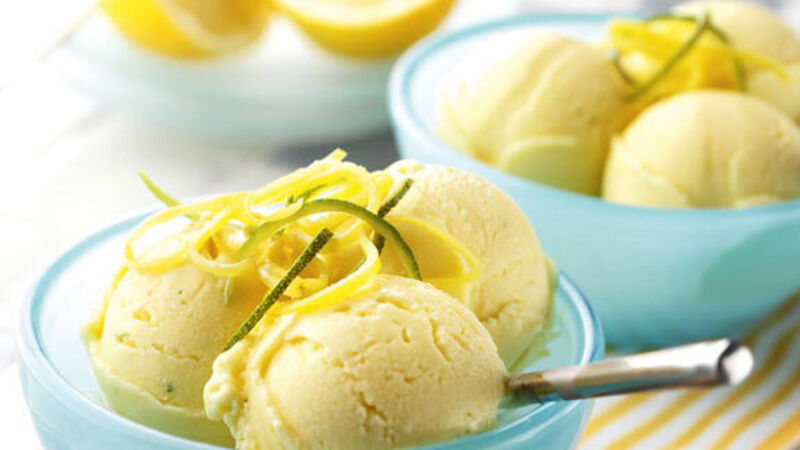Fresh Lemon Ice Cream with Crystallized Lemon Peel

Just a few weeks ago, the US Government’s Dietary Advisory Committee changed the long-standing official dietary advice to limit the number of eggs per person to a couple a week.
Instead they are recommending people to drastically restrict their sugar intake from an average of 22 to 30 teaspoons a day in the US.
How shocking is that? In Ireland we are not quite as bad at a “mere” 15-16 teaspoons per day but we are getting there fast with many children starting their day with a bowl of sugary cereal and a ‘fruit’ yoghurt or smoothie, which can contain up to seven teaspoons of sugar.
Back to eggs, time for us egg lovers to celebrate eggs. Mankind has been eating eggs, the original fast food since time began. When you think of it they are a wonder food, a neat package of nutrients and goodness.
Recent research has found that they contain even more vitamins and minerals and less calories than originally thought.
Around 1,000 years ago the Indians and Chinese started to domesticate chickens and then the Egyptians worked out how to incubate the eggs so the hens could get on with the business of laying.
If eggs were so bad for us, it’s just possible it would have been evident before the 1960s when some scientists began to connect eggs to heart disease. I thought of my granpoppy who ate a couple of eggs every day of his life and lived to a ripe old age.
However, those were beautiful fresh eggs from the flock of hens pecking around the haggard and farmyard and an altogether different thing from the mass-produced eggs layed by hens confined in ‘enriched’ cages.
For decades many people went to ‘work on an egg’. Then in the 1980s there was the panic about salmonella in eggs — a natural consequence of overcrowding and intensive production.
So how do you feel about eggs? Are you also concerned that they will increase your HDL cholesterol, well fear not, the thinking has changed.
However, remember an egg laid by a happy lazy hen is an altogether different thing to a mass- produced egg to which an increasing number of people are allergic. Why not join the new generation of hen keepers so you can enjoy the pleasure of having a regular supply of proper free range organic eggs.
A chicken coop on your lawn with four hens will recycle food scraps, provide enough eggs for a regular household and provide chicken manure for your compost heap.
For us cooks, it’s difficult to imagine life without eggs. They are one of the few foods considered to be a complete protein because they contain all the essential amino acids, the perfect package of nutrients and goodness and are super versatile in the kitchen.
Like cattle, hens need access to grass to produce real nourishment and flavour. Organic hens must be allowed to range freely but free range does not mean organic and can be a very ‘elastic’ term.
Eggs are incredibly good value, two or three for supper makes an inexpensive and nourishing meal.
This is a fresh, tangy, light ice cream, made from milk rather than cream. Easy peasy to make and a delight to eat at the end of any meal — winter or summer.
Separate the egg, whisk the yolk with the milk and keep the white aside. Gradually mix in the sugar. Carefully grate the zest from the lemon on the finest part of a stainless steel grater. Squeeze the juice from the lemon and add with the zest to the liquid.
Whisk the egg white until quite stiff and fold into the other ingredients. Freeze in a sorbetiere according to the manufacturer’s instructions or put in a freezer in a covered plastic container.
When the mixture starts to freeze, remove from the freezer and whisk again, or break up in a food processor. Then put it back in the freezer until it is frozen completely. Meanwhile, chill the serving plates.
To serve: Scoop the ice cream into the curls, arrange on chilled plates or in pretty frosted glass dishes. Decorate with crystallized lemon peel, borage flowers and fresh mint leaves if you have them.
Instead of the lemon juice and zest, use 3 tablespoons of elderflower syrup and 1 teaspoon of lemon juice. Proportions will depend on how sweet the flower syrup is. Just follow recipe as for lemon ice cream (milk, egg and sugar). For decoration: Deep fry a bunch of elder flower very quickly.
We always have lots of crystallized lemon, orange and lime peel in a jar to decorate tarts, scatter on mousses or just to nibble. Use 2 lemons; 16fl oz/450 ml/generous 2 cups cold water; and sugar syrup.
Peel 2 lemons very thinly with a swivel top peeler, be careful not to include the white pith. Cut the strips into fine julienne.
Put into a saucepan with the cold water and simmer for 5 minutes. Drain, refresh in cold water, cover with fresh water and repeat the process
Put the julienne into a saucepan with the syrup and cook gently until the lemon julienne looks translucent or opaque.
Remove with a slotted spoon and allow to cool on bakewell paper or a cake rack. When cold toss in castor sugar and allow to dry in a cool airy place.
Can be stored in a jar or airtight tin for weeks or sometimes months.
Those of us who are fortunate enough to have some space to keep a few free-range hens are blessed indeed. The eggs laid by my happy, lazy hens are completely perfect — white curdy albumen and rich yellow yolks.
When you have access to eggs of this quality, treat yourself to a boiled egg — absolute perfection but sadly a forgotten flavour for so many people.
Little fingers of toast called dippies or soldiers are the usual accessory but during the asparagus season in May a few spears of fresh green asparagus make a deliciously decadent dip.
Bring a small saucepan of water to the boil, gently slide in the eggs, bring the water back to the boil and simmer gently for 4-6 minutes, according to your taste.
A four minute egg will be still quite soft, five minutes will almost set the white while the yolk will still be runny, 6 minutes will produce a boiled egg with a soft yolk and solid white.
Meanwhile, toast the bread, cut off the crusts and spread with butter. Cut into fingers. Immediately the eggs are cooked, pop them into egg cups on large side plates.
Put the cooked asparagus and soldiers on the side and serve with a pepper mill, sea salt and a few pats of butter.
Bend the stalks of asparagus, over your index finger. It will snap where it begins to get tough (keep the ends for soup). Cook in boiling salted water for 5-8 minutes (depending on size) or until a knife will pierce the root end easily. Drain and keep hot.
A great way to use up left-over hot cross and of course this recipe can be adapted for barmbrack.
Split the hot cross buns, butter each side and cut into slices. Arrange the slices, buttered side down, in one layer in the buttered dish. Sprinkle the buns with half the spice and half the raisins, then arrange another layer over the raisins.
Sprinkle the remaining nutmeg and raisins on top. Cover the raisins with the remaining hot cross buns.
In a bowl whisk together the cream, milk, eggs, vanilla extract, sugar and the pinch of salt. Pour the mixture through a fine sieve over the bread. Let the mixture stand, loosely covered, at room temperature for at least one hour or chill overnight.
Preheat the oven to 180°C/350°F/Gas Mark 4.
Place the pudding in a bain-marie and pour in enough water to come half way up the sides of the baking dish. Bake the pudding in the middle of the oven for about one hour or until the top is crisp and golden. Serve warm with some softly whipped cream.
Note: This pudding reheats perfectly.
Turkish Scrambled Eggs
A favourite breakfast dish, there are lots of versions, some just crack the eggs onto the top, cover and allow to set but I love this version.
We used a deepish pan with a 7 inch base and a 9 inch top.
Heat the oil in a sauté pan and add the onion, peppers and chilli if using. Cover with a paper lid and sweat until soft but not coloured, about 5-6 minutes.
Add the tomatoes, season with salt and freshly ground black pepper and a little sugar. Cook for another 4 or 5 minutes.
Lightly whisk the eggs, gently season and stir into the base, continue to cook until softly set.
Stir gently once or twice then crumble the feta on top. Cover with a lid and continue to cook on the lowest heat for 15-20 minutes until just set.
Scatter with roughly chopped flat parsley, a drizzle of extra virgin olive oil and a few chilli flakes if you wish.
Serve immediately with lots of crusty bread.
The Burren Slow Food Festival will be launched at the Ballyvaughan Farmer’s Market on May 16. This year’s theme is Land & Sea.
The festival extends to a week of standalone events organised by the Burren Food Trail, food producers, chefs and restaurants.
Michelin-starred chef Derry Clarke from L’Ecrivain will be making an appearance at the festival, sharing his expertise in demos and talks. See www.slowfoodireland.com/event
The first new season’s Irish asparagus has started to appear in the Farmer’s Markets.
I bought my first precious bunch of the season from West Cork asparagus grower Tim York, 086 8593996, at the Schull Farmer’s Market on Easter weekend in the midst of the 15-year celebrations. Congratulations to all involved in this colourful vibrant market, every Sunday from 9.30am to 1pm. www.schullmarket.com















